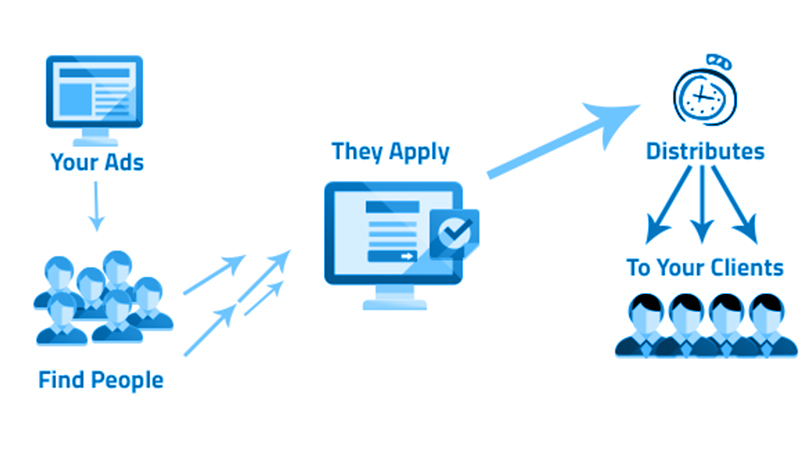Looking for a way to boost your sales and improve team performance? Automated lead distribution can be the answer. By automating the process of allocating leads, you not only benefit from increased efficiency but also higher-quality outcomes in general. In this blog post, we’ll explore the benefits of automated lead distribution, how it works, plus useful tips on proper implementation.
What is Automated Lead Distribution?
Automated lead distribution empowers organisations to prioritise efficiency, better quality leads, and consistent follow-up. Instead of requiring a manager to manually assign leads to reps, criteria such as source or score can be used for automated assignment in accordance with predefined rules. This streamlined process provides more accurate lead management without the time constraints associated with manual procedures – resulting in higher levels of success across teams!

What is Automated Lead Distribution?
The Difference between manual lead distribution and automated lead distribution
5 benefits of using automated lead distribution
Increased efficiency and productivity
Improved lead quality
More consistent lead follow up
Increased revenue
Improved customer experience
How Does Automated Lead Distribution Work?
3 types of lead distribution models
Round-robin lead distribution
Weighted lead distribution
Account-based lead distribution
5 best Practices for Implementing automated lead distribution
Define lead qualification criteria
Implement a lead distribution model
Integrate lead distribution software with CRM and marketing automation tools
Train sales reps on the lead distribution process
Lead nurturing
The Difference between manual lead distribution and automated lead distribution
Traditional lead distribution is often performed by a sales manager or team leader and can result in bias, depending on their personal judgment or preference. Through automated lead distribution, such issues are avoided by assigning leads based on predefined standards like source, score or area – consequently ensuring an impartial and consistent division of prospects.
This is all done by a lead distribution system, with the sole intention to route leads and create as much business efficiency as possible.
5 benefits of using automated lead distribution
To streamline sales and boost your team’s performance, automated lead distribution is the way to go.
Look no further than these six major advantages below.
1. Increased efficiency and productivity
Streamlining the process of delegating leads to sales reps, companies are able to save time while simultaneously reducing errors that can happen with manual lead distribution. Automated lead assigning makes sure leads are delegated precisely, allowing sales reps within sales teams, to concentrate on what they do best – selling!
2. Improved lead quality
With automated lead distribution, businesses can set up qualification criteria like source of the lead, score, or other relevant factors to guarantee that only the most qualified leads are allocated to sales representatives. This guarantees higher-quality leads and improves efficiency in sales conversations.
3. More consistent lead follow up
By automating the lead distribution process, businesses can guarantee that leads get distributed justly and consistently. This not only decreases friction between sales reps due to competition, but it will also boost your sales teams performance.
4. Increased revenue
Automated lead distribution has the potential to greatly increase businesses’ efficiency when it comes to dealing with leads, which can ultimately result in accelerated growth and profits.
5. Improved customer experience
Automating the lead distribution process guarantees that every single prospect is handled by your most skilled sales rep, leading to stronger customer conversations and an all-round enhanced experience. This can empower businesses to cultivate more robust customer relationships while also intensifying client loyalty.
How Does Automated Lead Distribution Work?
Automated lead distribution simplifies the process of allocating potential customers to sales reps. It’s a system that can be swiftly and accurately set up, regardless if it is done through CRM systems, marketing automation platforms or dedicated software applications. Let us now explore in greater detail how automated lead distribution works – from its algorithms and criteria for assignment to the tools needed for successful implementation.

3 types of lead distribution models
1. Round-robin lead distribution
Round-robin is a simple yet effective lead distribution model in which sales reps are allocated leads in an orderly fashion. This approach guarantees that no one rep receives all the leads, while others receive none. To illustrate: if there are four sales representatives, then each would be assigned one lead and after they’ve received their share, the cycle begins again from the first representative. In this way, everyone has access to a fair amount of prospects for conversion opportunities!
2. Weighted lead distribution
To ensure leads are allocated to the best-suited sales reps, weighted lead distribution is utilised by businesses. This system assigns leads according to predetermined criteria such as product proficiency and location. For instance, a business may give local leads to their regional representative for maximum efficiency and likelihood of sales success.
In contrast, businesses can assign leads to sales reps based on their product know-how. By allocating leads for a distinct product line to sales reps with the best understanding of that item, customers are more likely to convert due to being connected with an expert. This strategy maximises the potential for successful conversions and customer satisfaction.

3. Account-based lead distribution
Account-based lead distribution is a powerful model that has drastically improved the chances of successful conversions and long term customer relationships. This approach assigns an exclusive team of sales reps to specific accounts, particularly in enterprise sales where businesses typically have big and complex accounts that require attentive management. With this method, each account is managed by individuals who are well aware with its background as well as necessities which enables them to better serve their customers for sustained success.
5 best Practices for Implementing automated lead distribution
Automation is an invaluable asset for businesses that want to amplify their sales process and maximise the output of their sales force. Streamlined lead distribution can revolutionise your company’s success!
To get the most out of automated lead distribution, businesses should follow these best practices.
1. Define lead qualification criteria
Businesses should define clear criteria for what qualifies as a lead, such as lead source, lead score, or other factors. This ensures that only qualified leads are assigned to sales reps, improving lead quality and productivity.
2. Implement a lead distribution model
Choosing the right lead distribution model is critical to ensuring a fair and effective distribution of leads. Businesses should consider factors such as sales team size, lead volume, and sales goals when selecting a model.
3. Integrate lead distribution software with CRM and marketing automation tools
Integrating lead distribution software with a business’s CRM and marketing automation tools ensures that leads are assigned quickly and accurately, reducing the risk of errors and delays.
Monitor lead distribution performance: Businesses should regularly monitor lead distribution performance, such as lead response time and conversion rates, to identify areas for improvement and adjust the lead distribution process as needed.

4. Train sales reps on the lead distribution process
Sales reps should be trained on the lead distribution process to ensure that they understand how leads are assigned and what is expected of them in terms of follow-up.
Although manual lead distribution may seem like the simplest solution to many, it simply does not solve the issue. Not only is this approach incredibly time-consuming and vulnerable to mistakes, but these errors can result in overlooked chances and lost profit. Automated lead distribution ensures leads are quickly and accurately assigned, thus enhancing sales team productivity while improving overall lead quality.
5. Lead nurturing
By providing fast personalised communication to your leads, businesses can build trust and establish a strong relationship with their prospects, ultimately increasing the likelihood of converting them into customers. Overall, automated lead distribution enhances the lead nurturing process by acting as a powerful tool for businesses looking to streamline their lead nurturing process, improve their sales efficiency, and generate more revenue.
Automate lead distribution for better results
In conclusion, automated lead distribution can help streamline your sales pipeline and improve your sales team’s performance. By using the right lead distribution model, integrating your CRM and marketing automation tools, and training your team on the new system, you can achieve greater efficiency, consistency, and success in your sales efforts.
